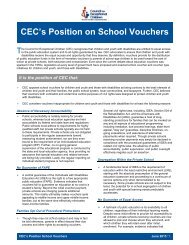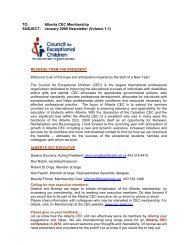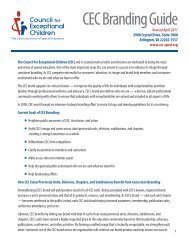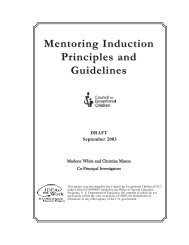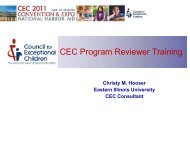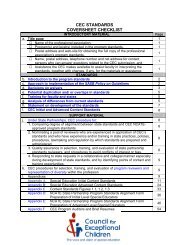What Every Must Know Special Educator - Council for Exceptional ...
What Every Must Know Special Educator - Council for Exceptional ...
What Every Must Know Special Educator - Council for Exceptional ...
You also want an ePaper? Increase the reach of your titles
YUMPU automatically turns print PDFs into web optimized ePapers that Google loves.
Several issues are confronting states and preparation<br />
programs related to licensure. These include preparing<br />
special educators <strong>for</strong> multicategorical practice, the use<br />
of high stakes assessments in licensing, the interfacing<br />
of skills needed by general and special educators to<br />
work in integrated collaborative teams.<br />
Multicategorical Licensure<br />
The majority of individuals are now licensed <strong>for</strong> multicategorical<br />
practice in special education (IPEDS, 2003,<br />
U.S. Department of Education, 2005). Many states use<br />
variations of titles such as Teachers of Individuals<br />
With Mild/Moderate <strong>Exceptional</strong>ities and Teachers of<br />
Individuals With Severe/Profound <strong>Exceptional</strong>ities to<br />
describe these multicategorical licenses. When states<br />
and provinces combine the essential knowledge and<br />
skill of special educators in the special education specialty<br />
areas, this is using a multicategorical licensing<br />
approach. Although most states and provinces now<br />
use a multicategorical licensing approach in special<br />
education, it is important that states balance the need<br />
<strong>for</strong> both breadth and depth of knowledge and skills<br />
<strong>for</strong> special education teachers. On the one hand, overly<br />
broad licensing approaches result in teachers who are<br />
not adequately prepared <strong>for</strong> the complex challenges of<br />
teaching individuals with exceptional learning needs.<br />
On the other hand, overly narrow licensing approaches<br />
at an entry-level do not prepare special education<br />
candidates <strong>for</strong> the increasing diversity of individuals<br />
with exceptional learning needs that special educators<br />
serve today. As the breadth of categories grow within<br />
Figure 2.3 Comparison of Professional Standards Frameworks<br />
CEC Curriculum Referenced Licensing and<br />
Accreditation Framework<br />
Individualized General Curriculum Mild/moderate disabilities<br />
(ages 5-14,12-21)<br />
Individualized Independence Curriculum Severe/multiple disabilities<br />
(ages 5-21)<br />
Deaf/Hard of Hearing Deaf/hard of hearing (ages<br />
birth-21)<br />
Blind/Visually Impaired Visual Impairments (ages<br />
birth-21)<br />
Early Childhood <strong>Special</strong> Education Early childhood (ages<br />
birth-21)<br />
Gifted/Talented <strong>Special</strong> Education<br />
*As suggested in INTASC (2001, May), Appendix A, p. 40.<br />
a multicategorical license, the challenge to prepare<br />
candidates <strong>for</strong> professionals practice becomes more<br />
challenging.<br />
To support states/provinces that use a multicategorical<br />
approach to licensing, CEC has the Curriculum<br />
Referenced Licensing and Program Accreditation<br />
Framework. The Individualized General Education<br />
Curriculum and the Individualized Independence<br />
Curriculum delineate the consensually validated<br />
knowledge and skills <strong>for</strong> multicategorical licenses, and<br />
reference the curricula in which the licensed teacher<br />
will practice.<br />
Complementary General and <strong>Special</strong> <strong>Educator</strong><br />
Roles<br />
Based on the premise that the standards <strong>for</strong> national program<br />
recognition and state licensure should align, CEC<br />
organized its professional standards to align explicitly<br />
with the INTASC 10 principles <strong>for</strong> model licensing<br />
standards at the entry level and with the NBPTS at the<br />
advanced level. It is encouraging that the licensing and<br />
certification approaches suggested by both the <strong>Council</strong><br />
of Chief State School Officer’s Interstate New Teacher<br />
Assessment and Support Consortium (INTASC) and<br />
National Board <strong>for</strong> Professional Teaching Standards<br />
(NBPTS) align with the CEC Curriculum Referenced<br />
Licensing and Program Accreditation Framework.<br />
This alignment reflects a strong national convergence<br />
regarding the balance of depth and spread (Figure 2.3),<br />
and it reflects the explicit intentions of CEC, INTASC,<br />
INTASC* NBPTS <strong>Exceptional</strong> Needs<br />
Certificate<br />
Mild and Moderately Impaired<br />
Severe and Multiply Impaired<br />
Deaf/Hard of Hearing<br />
Visually Impaired<br />
Early Childhood<br />
SECtion : aSSuring WEll-prEparEd SpECial EduCation proESSionalS 1




